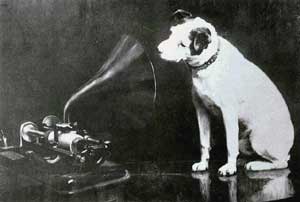Nipper and Friends
The black and white fox terrier, quizically staring at an antique horn-type phonograph and the words “His Master’s Voice,” has been a well-known corporate trademark for more than a century. This image originated as an original painting by Francis Bauraud of a stray dog he had taken in, whose name was Nipper. The original painting showed Nipper staring into the horn of a cylinder phonograph, and this painting sat forgotten in a studio for many years. Later, the artist was encouraged by a friend to go back to the painting and replace the original black horn with a more up-to-date brass horn. Barraud borrowed a new horn from the offices of the Berliner Gramophone Company’s branch in England. The president of the company, William Owen, was interested in what was going on and dropped by Barraud’s London studio. When he saw the painting, he offered to buy it if the artist would paint in a Berliner gramophone for the Edison cylinder machine.
It was some time before the painting was adopted as a trademark in Europe. The Gramophone Company already had an icon— the “recording angel” drawing that appeared on all Gramophone record labels. Emile Berliner, however, immediately registered the image as a U.S. trademark when he saw it around 1900. Eldridge Johnson, who worked with Berliner, began using it on his phonographs, and its usage continued when Johnson and Berliner merged their companies to form Victor Talking Machine Co. in 1901. The icon survived the merger of Victor with RCA in 1929 and is still used today. Nipper, however, died in 1895 and is buried under a mulberry tree on Eden Street, Kingston-on-Thames. The spot was marked by a plaque in 1949.
Although Nipper remains the most recognizable corporate icon of the phonograph industry, he was not the only animal mascot. The Pathe brothers, makers of phonographs and records in France, used a feisty rooster as their corporate symbol. The rooster represented the crafty Chantecleer of French folklore, and its motto was “Je chante haut et clair” (I sing high and clear).
With the success of Nipper and Chantecleer, competing companies were eager to find their own insignia. The Lambert Company, a short-lived maker of cylinders, hoped to visually convey the durability of their celluloid plastic cylinders. In 1903 they adopted as a symbol an elephant balancing on top of a giant Lambert cylinder with the slogan, “Can’t break em.” Unfortunately, the cylinders proved more durable than the company, which went bankrupt just a few years later.
The same year Lambert placed their hopes on an elephant, the Ohio Talking Machine Company took a cue from Victor and used a dog in their advertising. Their version, more than slightly similar to Victor’s, showed a black poodle sitting with its back to a horn and the words “Familiar Voices.” Later they changed their logo to a parrot in front of a horn and the slogan “Learning Some New Ones.” Some species were definitely favored by the record industry. Around 1916, there was an explosion of labels named in honor of songbirds as smaller companies began entering the growing phonograph market. Insects, on the other hand, are represented only in Busy Bee records (1904), inspired by the last name of founder Sherman Bisbee, and felines solely by the Lyric record Kitten (“Never Scratches”), introduced by the Lyrephone Company of America in 1917.
